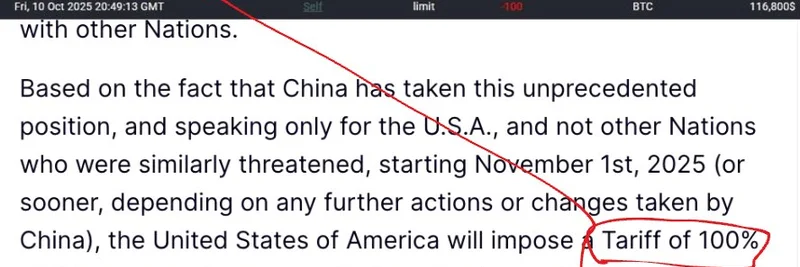In the fast-paced world of crypto, where fortunes can flip in minutes, conspiracy theories often swirl around major market events. The recent October crash, which wiped out $19.1 billion in value and liquidated over 1.6 million traders in under 24 hours, is no exception. A intriguing thread from X user @StarPlatinumSOL lays out a compelling theory tying the crash directly to a post by former President Donald Trump about imposing 100% tariffs on China. Let's break it down step by step and explore what this means for meme token enthusiasts and the broader blockchain space.
The Spark: Trump's Tariff Announcement
It all kicked off with Trump's post on Truth Social, where he revealed China's aggressive trade stance and announced that the U.S. would slap a 100% tariff on Chinese goods starting November 1, 2025—or even sooner if needed. This wasn't just political rhetoric; it sent shockwaves through global markets, including crypto, which is highly sensitive to macroeconomic news.
According to the theory, this post wasn't random. About 30 minutes before it went live, a freshly created wallet funded an account on Hyperliquid—a decentralized exchange that skips KYC (Know Your Customer) requirements. This wallet, born between October 9 and 10, received between $80 million and $160 million in USDC via Arbitrum. Then, it opened massive short positions on Bitcoin (BTC) and Ethereum (ETH), totaling around $1.1 billion in notional value.
- BTC shorts: $419M–$752M at 6–10x leverage
- ETH shorts: $330M–$353M at 12x leverage
The timing is suspicious—the last $23 million ETH short was placed just one minute before Trump's post. As the market tanked, this trader closed positions at the absolute bottom, pocketing $160–$200 million in profits. Luck? Or something more calculated?
The Crash Unfolds: Exchanges Glitch and Wallets Move
As prices plummeted, major centralized exchanges like Binance and Bybit reported "technical issues," preventing many traders from closing their positions and amplifying the liquidations. Meanwhile, our mysterious wallet executed flawlessly. Coincidence?
Adding fuel to the fire, the Trump family holds over $5 billion in crypto through World Liberty Financial (WLFI), a project tied to their interests. Their main treasury wallet (0x5be9a4959308a0d0c7bc0870e319314d8d957dbb) is a Gnosis multisig holding $2.7 billion+ across Ethereum, Solana, and BNB Chain. During the crash, WLFI and the TRUMP memecoin dipped 25–30%, but the family didn't sell. Instead, WLFI bought back $1.4 million worth of tokens over the weekend using the treasury.
Market maker Wintermute also shuffled billions in WBTC (Wrapped Bitcoin) that day, calling it "liquidity management." But the alignment with the crash raises eyebrows.
Piecing Together the Theory
@StarPlatinumSOL's hypothesis connects the dots:
- Insider knowledge of Trump's post timing allowed someone to front-run the market with huge shorts.
- Billions flowed into exchanges to capitalize on the impending drop.
- Exchanges and market makers like Wintermute and Binance may have coordinated to maximize profits by letting the crash run wild.
- The Trump team benefited by flushing out leveraged positions, stabilizing their holdings in WLFI and related assets.
This isn't just about BTC and ETH—meme tokens felt the heat too. The TRUMP memecoin, often pumped on political hype, took a hit but could rebound if tariffs boost "America First" narratives in crypto circles. WLFI, as a Trump-backed project, might see indirect gains from market resets that weed out weak hands.
What This Means for Meme Token Traders
For those in the meme token game, this theory highlights the risks of geopolitical events spilling into crypto. Meme coins like TRUMP thrive on sentiment, and a 100% tariff war could spark volatility. If true, it underscores how insiders—possibly with political ties—can manipulate markets, leaving retail traders liquidated.
On the flip side, it's a reminder to DYOR (Do Your Own Research) and use decentralized platforms like Hyperliquid for anonymity, though that comes with its own risks. Blockchain practitioners should watch on-chain data closely; tools like Etherscan or Solana Explorer can reveal wallet movements before they hit the news.
If you're holding Solana-based memes or Trump-related tokens, consider hedging against macro shocks. The crypto world is intertwined with global politics more than ever, and theories like this one keep us vigilant.
What do you think—plausible insider play or just tinfoil hat territory? Drop your takes in the comments, and stay tuned to Meme Insider for more breakdowns on how real-world events shake up the meme token ecosystem.


